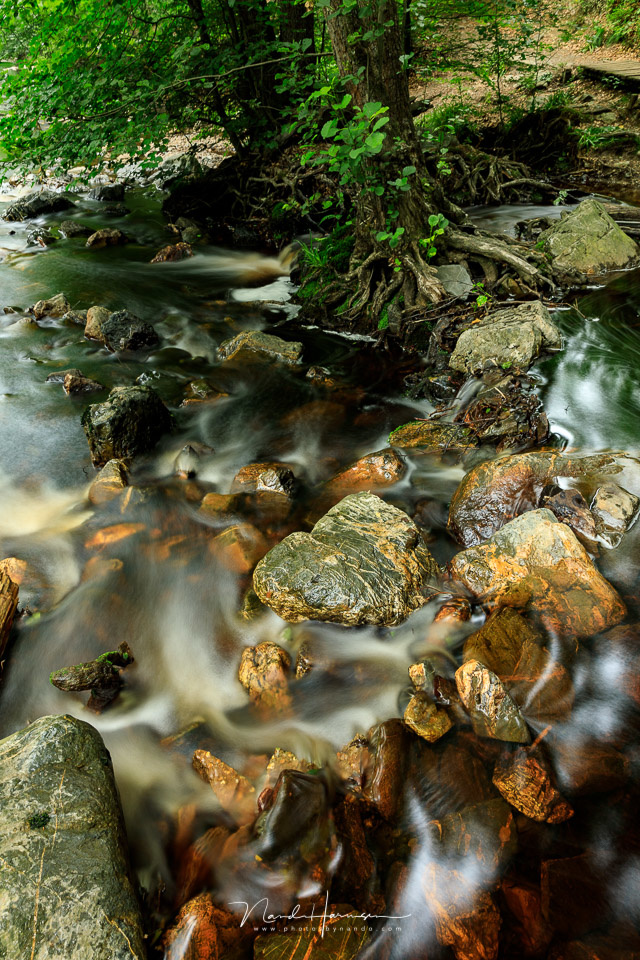Haida released the M10 Insert Variable ND filter for their M10 filter system. It has to be used with the normal M10 circular polarization filter. Haida kindly provided me with the brand new variable neutral density filter to try it out. These are my findings.
Haida reached out to me with the question to review the brand new variable neutral density filter for the Haida M10 filter system. It is for the user that love using variable neutral density filter, as told on their website. I quote: “We did little research recently. It seems many photographers are really tired while changing the Filter holders to the Variable ND. Which means they need to take the adapter ring off from the lens and then screw on the Variable ND.”
The M10 insert Variable ND filter should be the answer for these photographers. It is a 100 x 100mm filter, made of K9 Optical Glass with low color-cast, scratch proof and water proof coating, and the typical R5 rounded corners. It has to be used with the normal M10 drop-in circular polarization filter, which comes in three different flavors.

There it is, the brand new Haida M10 Insert Variable ND filter, for use with the filter holder and a CPL filter.
About the Filter Itself
The filter I received from Haida is a pre-production model, without any text or information on it. I was confused to see this almost transparent piece of glass, wondering how it would work. But it seemed to be a polarization filter, that combined with another polarization filter is able to block light depending on the individual orientation.

Using the Haida M10 Insert Variable ND filter in real life, while photographing a small stream in the middle of the Belgium Ardennes
This is exactly how a variable neutral density filter works. It consists out of two polarization filters that can rotate independently to each other. With regular variable neutral density filters, the two filters are build into a single filter with rotation capability. Although the filters will use polarization, it is not meant for that purpose. For the Haida variable neutral density you have two separate pieces of glass.
How Much Light Does the M10 Insert Variable ND Filter Hold
With the Haida M10 filter system you can choose between a normal polarization filter (CPL filter), or a CPL combined with neutral density glass. There is the CPL filter with a ND0.9 (3 stops) and a CPL with a ND1.8 (6 stops). If these CPL filters are combined with the new M10 Insert Variable ND filter, you can hold up to 9 stops of light.
- Combine M10 drop-in CPL with M10 Insert Variable ND: 2-4 stops (ND2 – ND16)
- Combine M10 drop-in CPL + ND0.9 with M10 Insert Variable ND: 3-5 stops (ND8 – ND32)
- Combine M10 drop-in CPL + ND1.8 with M10 Insert Variable ND: 6-9 stops (ND64 – ND500)
If you only need to hold 1 stop of light, only the CPL filter will do.

A set of Haida M10 drop-in CPL filters, next to the ordinairy ND filters. With the M10 Insert Variable ND you can manipulatie the amount of light that reaches the lens.
Downsides of a Variable neutral density Filter
You need to be aware of the downsides of a variable neutral density filter. This has nothing to do with the brand, but it is all about physics. As you may know, by polarizing the light only one direction of the light will be able to pass through the glass. This makes it possible to reduce glare in shiny and wet surfaces. If you use a second polarization glass, you are also able to block the remaining direction of light. It is the basic principle on which the variable neutral density filters work.
If you turn the two polarization filters too far, a dark cross will emerge, rendering the filter useless. It is important to rotate the filter not too far, in order to avoid the cross effect. This effect will become more prominent when an ultra-wide angle lens is being used. Even with 24mm on full frame, the effect is noticeable.

I made this animated gif to show what happens when a variable ND filters is turned too far. A black cross emerges due to the two polarization directions.
When a Variable ND Filter Will Do Nicely
If a variable ND filter will produce the dark cross effect, it may seem a useless filter at first sight. Especially with ultra-wide angle lenses. But if you use the variable ND filter on a longer focal length, like 35mm full frame equivalent and longer, the cross effect will become less obvious.
So why would you use a variable neutral density filter? At first I thought it would be just an alternative for those who don''t want to buy a lot of ND filters. But while photographing in the Belgium Ardennes I discovered how well the Haida M10 Insert Variable ND filter can work if the shutter speed is really important.

The Haida M10 Insert Variable ND filter is perfect for getting the exact exposure time without changing aperture or ISO level.
When photographing water streams and small waterfalls, the exposure time can be very critical. Too long and the water loses all detail, too short and you end up with too much detail. With a regular neutral density filter you can only manipulate the exposure time by changing the ISO level. In theory you could also use the aperture, but it will change the depth of field also. I don’t want that.

With the Haida M10 Insert Variable ND filter I could change the exposure without changing the depth of field, while maintaining the lowest ISO level. (Canon EOS 5D4 EF24-70mm f/2,8L II @ 24mm - ISO100 - f/16 - 30 seconds - Haida VND Red Diamond medium 0,9 GND)
With a variable neutral density filter you can play around with the amount of light that passes through the filter, thus manipulating the exposure time without changing aperture or ISO levels. This also applies with photographing waves on a beach. It allows you to get the exposure time you need.

I used a regular Haida Red Diamond ND1000 filter for this, but to play around with the exposure time to have the exact amount of movement, a variable ND filter would have been perfect. (Canon EOS 5D4 Laowa 12mm - ISO400 - f/11 - 1,3 seconds - ND1000)
My Experience With the M10 Insert Variable ND Filter
When using the Haida M10 Insert Variable ND filter on the beach and with the small stream, it allowed me to get the exact shutter speed just by rotating the CPL filter. I could keep my aperture exactly as I wanted, and the ISO as low as possible.
But I noticed how the amount of polarization changed while rotating the CPL filter, especially in the forest with the stream. Fortunately I was able to rotate the complete filter holder to keep the amount of polarization. As long as the relative orientation of the CPL filter and the M10 Insert Variable ND filter stayed the same, this was no problem. But you will lose the ability of orientating a gradient neutral density filter if you need one.

Unfortunately using the Haida M10 Insert Variable ND filter means you cannot control the polarization of the light of removing glare when combining with gradient neutral density filters like in this example.
I also use a Laowa 12mm Zero-D lens for my landscape photography, with its own dedicated 100x100mm filter holder. I can use 100x100 neutral density filters without any problem, but the version I have doesn’t accept a normal CPL filter. That is when I realized I could use the Haida M10 Insert Variable ND filter, which is basically nothing more than a polarization filter on its own. It is a nice bonus.

I used the Haida M10 Insert Variable ND filter in the Laowa dedicated filter holder, to remove glare in this scenery. (Canon EOS 5D4 Laowa 12mm - ISO100 - f/11 - 6 sec - Haida VND filter)
What I Liked About the Haida M10 Insert Variable ND filter
- No visible color-cast
- It brings a variable ND filter to a filter holder
- Scratch proof and water proof coating (not tested)
- It incorporates a variable neutral density filter in a filter system
- The different M10 drop-in CPL filters with ND capability allows an extensive range of stops
- It is also usable as a polarization filter on its own
- It can be used with other brands filter holders and polarization filters
What I Disliked About the Haida M10 Insert Variable ND filter
- It is not a compact variable ND filter because you need the M10 filter holder and CPL filter
- It is not practical for filming, because the complete package is too large
- For the complete range of stops you still need three different CPL filters

Using gradient filters in combination with the Haida M10 Insert Variable ND filter is possible, but you loose control over removing glare in wet surfaces.
Some More Likes and Dislikes
But wait, there is more. The likes and dislikes as mentioned above are about the Haida M10 Insert Variable ND filter. But I also have some likes and dislikes about variable neutral density filters in general. First of all, what I like is the ability to manipulate the exposure time without the need of changing aperture or ISO. It is a big plus when photographing with a critical exposure time.
On the other hand, I don’t like losing all flexibility with the polarization itself. I have the feeling there is no full control anymore. And of course the dark cross that emerges when the filter is rotated too far. Is starts to appear slowly in the corners. It will probably surprised you at home, when you notice how dark two corners have become. It may be recoverable, but I would prefer to avoid it.

For this shot I turned the Haida M10 Insert Variable ND filter a bit too far. Can you see the uneven exposure in the image? On site, while looking at the small LCD screen, it might be difficult to see. This much is recoverable in post-processing.
I want to thank Haida for providing me with the M10 Insert Variable ND filter. I think it is a great addition to the available filters, and it definitely has a good use for those photographers who love variable neutral density filters.
How about you? Have you ever used a variable neutral density filter, and what do you think about it? Tell me about your thoughts on this filter from Haida. I love to read your opinion in the comments below.








